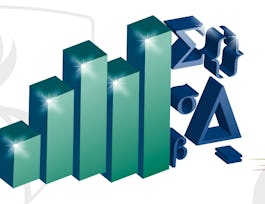This course covers the essential exploratory techniques for summarizing data. These techniques are typically applied before formal modeling commences and can help inform the development of more complex statistical models. Exploratory techniques are also important for eliminating or sharpening potential hypotheses about the world that can be addressed by the data. We will cover in detail the plotting systems in R as well as some of the basic principles of constructing data graphics. We will also cover some of the common multivariate statistical techniques used to visualize high-dimensional data.


Exploratory Data Analysis
This course is part of multiple programs.
Taught in English
Some content may not be translated



Instructors: Roger D. Peng, PhD
177,653 already enrolled
Included with 
Course
(6,056 reviews)
94%
What you'll learn
Understand analytic graphics and the base plotting system in R
Use advanced graphing systems such as the Lattice system
Make graphical displays of very high dimensional data
Apply cluster analysis techniques to locate patterns in data
Skills you'll gain
Details to know

Add to your LinkedIn profile
2 quizzes
Course
(6,056 reviews)
94%
See how employees at top companies are mastering in-demand skills

Build your subject-matter expertise
- Learn new concepts from industry experts
- Gain a foundational understanding of a subject or tool
- Develop job-relevant skills with hands-on projects
- Earn a shareable career certificate


Earn a career certificate
Add this credential to your LinkedIn profile, resume, or CV
Share it on social media and in your performance review

There are 4 modules in this course
This week covers the basics of analytic graphics and the base plotting system in R. We've also included some background material to help you install R if you haven't done so already.
What's included
15 videos6 readings1 quiz5 programming assignments1 peer review
Welcome to Week 2 of Exploratory Data Analysis. This week covers some of the more advanced graphing systems available in R: the Lattice system and the ggplot2 system. While the base graphics system provides many important tools for visualizing data, it was part of the original R system and lacks many features that may be desirable in a plotting system, particularly when visualizing high dimensional data. The Lattice and ggplot2 systems also simplify the laying out of plots making it a much less tedious process.
What's included
7 videos1 reading1 quiz5 programming assignments
Welcome to Week 3 of Exploratory Data Analysis. This week covers some of the workhorse statistical methods for exploratory analysis. These methods include clustering and dimension reduction techniques that allow you to make graphical displays of very high dimensional data (many many variables). We also cover novel ways to specify colors in R so that you can use color as an important and useful dimension when making data graphics. All of this material is covered in chapters 9-12 of my book Exploratory Data Analysis with R.
What's included
12 videos1 reading4 programming assignments
This week, we'll look at two case studies in exploratory data analysis. The first involves the use of cluster analysis techniques, and the second is a more involved analysis of some air pollution data. How one goes about doing EDA is often personal, but I'm providing these videos to give you a sense of how you might proceed with a specific type of dataset.
What's included
2 videos2 readings1 programming assignment1 peer review
Instructors

Offered by
Recommended if you're interested in Data Analysis

Johns Hopkins University

Coursera Project Network

Johns Hopkins University

Johns Hopkins University
Why people choose Coursera for their career




Learner reviews
Showing 3 of 6056
6,056 reviews
- 5 stars
74.29%
- 4 stars
21.12%
- 3 stars
3.40%
- 2 stars
0.74%
- 1 star
0.42%
New to Data Analysis? Start here.

Open new doors with Coursera Plus
Unlimited access to 7,000+ world-class courses, hands-on projects, and job-ready certificate programs - all included in your subscription
Advance your career with an online degree
Earn a degree from world-class universities - 100% online
Join over 3,400 global companies that choose Coursera for Business
Upskill your employees to excel in the digital economy
Frequently asked questions
Access to lectures and assignments depends on your type of enrollment. If you take a course in audit mode, you will be able to see most course materials for free. To access graded assignments and to earn a Certificate, you will need to purchase the Certificate experience, during or after your audit. If you don't see the audit option:
The course may not offer an audit option. You can try a Free Trial instead, or apply for Financial Aid.
The course may offer 'Full Course, No Certificate' instead. This option lets you see all course materials, submit required assessments, and get a final grade. This also means that you will not be able to purchase a Certificate experience.
When you enroll in the course, you get access to all of the courses in the Specialization, and you earn a certificate when you complete the work. Your electronic Certificate will be added to your Accomplishments page - from there, you can print your Certificate or add it to your LinkedIn profile. If you only want to read and view the course content, you can audit the course for free.
If you subscribed, you get a 7-day free trial during which you can cancel at no penalty. After that, we don’t give refunds, but you can cancel your subscription at any time. See our full refund policy.

